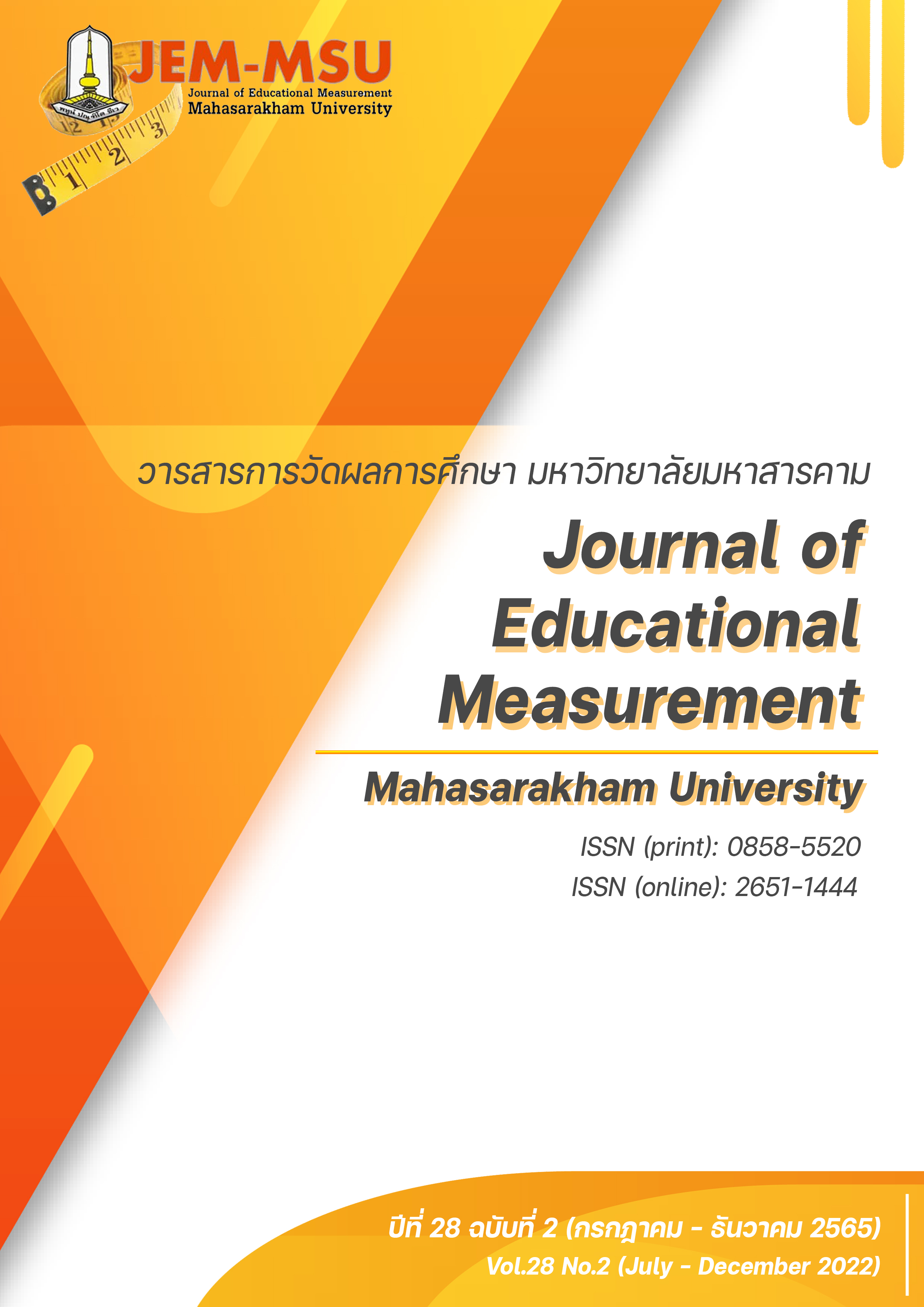การประเมินเพื่อการเรียนรู้ในการแก้ปัญหาทางคณิตศาสตร์แบบฮิวริสติกส์ สำหรับนักเรียนชั้นมัธยมศึกษาปีที่ 3
Main Article Content
บทคัดย่อ
การวิจัยครั้งนี้มีวัตถุประสงค์เพื่อ 1) ศึกษาแนวทางการใช้การประเมินเพื่อการเรียนรู้ในการส่งเสริมการแก้ปัญหาทางคณิตศาสตร์แบบฮิวริสติกส์สำหรับนักเรียนชั้นมัธยมศึกษาปีที่ 3 2) เพื่อศึกษาความสามารถในการแก้ปัญหาทางคณิตศาสตร์ของนักเรียนชั้นมัธยมศึกษาปีที่ 3 ที่ได้รับการประเมินเพื่อการเรียนรู้ในการแก้ปัญหาทางคณิตศาสตร์แบบฮิวริสติกส์ 3) เพื่อศึกษาความคิดเห็นของนักเรียนที่มีต่อการประเมินเพื่อการเรียนรู้ในการแก้ปัญหาทางคณิตศาสตร์แบบฮิวริสติกส์สำหรับนักเรียนชั้นมัธยมศึกษาปีที่ 3 การวิจัยนี้เป็นวิจัยเชิงปฏิบัติการ (action research) กลุ่มเป้าหมายที่ใช้ในการวิจัยเป็นนักเรียนชั้นมัธยมศึกษาปีที่ 3 โรงเรียนสารวิทยา ภาคเรียนที่ 2 ปีการศึกษา 2562 จำนวน 49 คน เครื่องมือที่ใช้ในการวิจัยประกอบด้วยแผนการจัดการเรียนรู้ แบบวัดความสามารถในการแก้ปัญหาทางคณิตศาสตร์ และแบบสอบถามความคิดเห็นของนักเรียนที่มีต่อการประเมินเพื่อการเรียนรู้ในการแก้ปัญหาทางคณิตศาสตร์แบบฮิวริสติกส์ วิเคราะห์ข้อมูลเชิงคุณภาพด้วยการวิเคราะห์เนื้อหา และข้อมูลเชิงปริมาณด้วยค่าเฉลี่ย ร้อยละ และส่วนเบี่ยงเบนมาตรฐาน
ผลการวิจัยพบว่า การประเมินเพื่อการเรียนรู้ในการแก้ปัญหาทางคณิตศาสตร์แบบฮิวริสติกส์ เป็นการนำวิธีการของการประเมินเพื่อการเรียนรู้ ได้แก่ การใช้บัตร entrance ticket การใช้คำถามกระตุ้นความคิด การใช้กิจกรรมกระตุ้นให้นักเรียนปฏิบัติและแสดงความสามารถ การเขียนบันทึกการเรียนรู้ และการให้ข้อมูลย้อนกลับ (Feedback) ไปใช้ประเมินในทุกขั้นของการจัดกิจกรรมการเรียนรู้ในการแก้ปัญหาทางคณิตศาสตร์แบบฮิวริสติกส์เพื่อให้นักเรียนเกิดการเรียนรู้และพัฒนาตนเองให้ดียิ่งขึ้น ทั้งนี้นักเรียนส่วนใหญ่ มีความสามารถในการแก้ปัญหาทางคณิตศาสตร์ เรื่อง โจทย์ปัญหาอสมการเชิงเส้นตัวแปรเดียว ชั้นมัธยมศึกษา ปีที่ 3 อยู่ในระดับปานกลาง และนักเรียนมีความคิดเห็นอยู่ในระดับเห็นด้วยว่าการประเมินเพื่อการเรียนรู้ในการแก้ปัญหาทางคณิตศาสตร์แบบฮิวริสติกส์ สำหรับนักเรียนชั้นมัธยมศึกษาปีที่ 3 มีความเหมาะสมในทุกด้าน
Article Details

อนุญาตภายใต้เงื่อนไข Creative Commons Attribution-NonCommercial-NoDerivatives 4.0 International License.
เนื้อหาและข้อมูลในบทความที่ลงตีพิมพ์ในวารสารการวัดผลการศึกษา มหาวิทยาลัยมหาสารคาม ถือเป็นข้อคิดเห็นและความรับผิดชอบของผู้เขียนบทความโดยตรง ซึ่งกองบรรณาธิการวารสาร ไม่จำเป็นต้องเห็นด้วย หรือร่วมรับผิดชอบใดๆ
บทความ ข้อมูล เนื้อหา รูปภาพ ฯลฯ ที่ได้รับการตีพิมพ์ในวารสารการวัดผลการศึกษา มหาวิทยาลัยมหาสารคาม ถือเป็นลิขสิทธิ์ของวารสารการวัดผลการศึกษา มหาวิทยาลัยมหาสารคาม หากบุคคลหรือหน่วยงานใดต้องการนำทั้งหมดหรือส่วนใดส่วนหนึ่งไปเผยแพร่ต่อหรือกระทำการใดๆ จะต้องได้รับอนุญาตเป็นลายลักษณ์อักษรจากวารสารการวัดผลการศึกษา มหาวิทยาลัยมหาสารคาม ก่อนเท่านั้น
เอกสารอ้างอิง
Assessment Reform Group. (2002). Assessment for Learning: 10 Principles.http://www.assessment-reform-group.org.uk/
Black, P., Harrison, C., Lee, C., Marshall. B., and Wiliam. D. (2004). Assessment for Learning in the Classroom. Phi Delta Kappan, 86(1), 8-21.
Black, P. and Wiliam, D. (1998). Assessment and classroom learning. Assessment in Education, 5(1), 7-74.
Denise, M.R. (2010). The Effects of Heuristic Problem-Solving Strategies on Seventh Grade Students' Self-Efficacy and Level of Achievement in Mathematics [Master of Science in Education]. https://core.ac.uk/download/pdf/233569385.pdf
Earl, L. and Katz, S. (2006). Rethinking Classroom Assessment with Purpose in Mind: Assessment for Learning, Assessment as Learning, Assessment of Learning. Imprime Au Canada.
Floyd, C. (2002). Problem solving as a strategy for learning mathematics. Lesson plan Project-Lit (Online). http://www.mtsu.edu/
Krulik, S. and Rudnick, J. (1995). The New Sourcebook for Teaching Reasoning and Problem Solving in Elementary School. Allyn and Bacon.
Polya, G. (1957). How To Solve: it A New Aspect of Mathematical Method. Doubleday and Company.
Stiggins, R.J., Arter, J.A., Chappuis, J. and Chappuis, S. (2012). Classroom Assessment for Student Learning: Doing it right – using it well. 2nd ed. ETS Assessment Training Institute.
The National Centre for Excellence in the Teaching of Mathematics. (2014). Assessment for learning in Mathematics. https://www.ncetm.org.uk/public/files/725964/Assessment+for+Learning+in+Mathematics.pdf/
Wiliam, D., Lee, C., Harrison, C. and Black, P. (2004). Teacher developing assessment for learning: Impact on Student achievement. Assessment in Education,11(1), 49-65.
Yen, F. (1985). An Intervention Study in Mathematical Problem Solving among Selected Junior High School Students. http://thailis.uni.net.th/dao/detial.nsp/
Bureau of Academic Affairs and Educational Standard. (2008). Indicators and core content in Mathematics Department based on The Basic Education Core Curriculum B.E.2551 (A.D.2008). Printing Agricultural Cooperative Federation of Thailand. (in Thai)
Bureau of Academic Affairs and Educational Standard. (2017). Assessment for learning: questioning technique and providing feedback for encourage learning. Printing Agricultural Cooperative Federation of Thailand. (in Thai)
Bureau of Educational Testing. (2014). Training courses on techniques for classroom Assessment. Printing Agricultural Cooperative Federation of Thailand. (in Thai)
Chuntra, C. (2011). Unit 14 Assessment of Learners’Mathematical Abilities. Provision Learning Experience in Mathematics. Sukhothai Thammathirat Open University Press. (in Thai)
Leelaphun, S. (2015). The Study of Mathematics Learning Achievement and Ability in Solving Problems of Mathayomsuksa Two Students on “Variation” by Using Heuristics at Setthabutbamphen School [Master’s thesis]. Kasetsart University. (in Thai)
Makanong, A. (2010). Mathematical skills and process: Development for Development. Centre for Educational book, Faculty of Education, Chulalongkorn University. (in Thai)
Meesuk, R. (2013). The effects of learning emphasized Heuristics thinking on mathematical achievement, problem solving and reasoning abilities on polynomial fractions of mathayomsuksa III students [Master’s thesis]. Srinakharinwirot University. (in Thai)
Mekwilaiphan, N. (2016). Assessment for learning in Mathematics for Mathayomsuksa 6 Student at Bangplama soongsumarnphadungwit school. Phranakhon Rajabhat Research Journal (Humanities and Social Sciences), 11(1), 17-29. (in Thai)
Naoyenpol, P. (1994). The development ability in mathematics problems solving. Mathematical Journal, 38(434-435), 62-67, 81-82. (in Thai)
National Institute of Educational Testing Service (Public Organization). (2008). Self learning kit: Measurement and Evaluation of Mathayomsuksa 1-6 Students, Mathematics Department. BOWT. (in Thai)
On-Ouen, K. (2014). The Approach of Assessment for Learning in Mathematics for Matthayom 4 [Master’s thesis]. Kasetsart University. (in Thai)
Pintip, P. (2017). The Study of Mathematics Learning Achievement and Word Problem Solving Ability of Mathayomsuksa Three Students on “Surface Area and Volume” Using Heuristics Problem Solving at Watjuntrawat (Sukprasarnrat) School, Changwat Phetchaburi [Master’s thesis]. Kasetsart University. (in Thai)
Rattanabunterng, C. (2014). The Study of Mathematics Learning Achievement and Word Problem Solving Ability of Mathayomsuksa Two Students on “Quadratic Equation with One Variable” by Using Heuristics Problem Solving at Samutsakornburana School, Changwat Samut Sakhon [Master’s thesis]. Kasetsart University. (in Thai)
Sodsangaroonngam, S. (2014). The study of Mathematics Learning Achievement of Mathayomsuksa Two Students on “Applications of linear Equations with One Variable” by Emphasizing Heuristics Thinking at Phrapathom Witthayalai School, Changwat Nakhon Pathom [Master’s thesis]. Kasetsart University. (in Thai)
The institute for the Promotion of Teaching Science and Technology. (2012). Mathematical Assessment. SE-EDUCATION Public Company Limited. (in Thai)
Thipkong, S. (2001). Problem Solving. Kurusapa Printing Ladphrao. (in Thai)
Wongyai, W., and Patphol, M. (2014). Cognitive Coaching. 3rd ed. Charansanitwong Printing. (in Thai)


